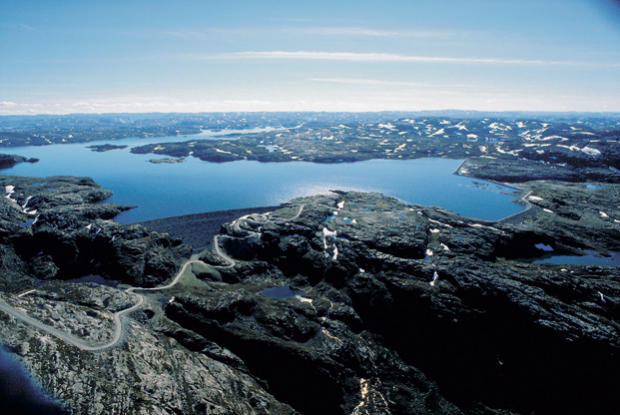Lake Blåsjö, Norway.
Hydro storage is basically a renewable battery. Lake Blåsjö (“Blue Lake”) in Norway with a capacity of 7.8 terrawatthours (TWh) has become a symbol of Norway’s potential to become a “Blue Battery” for Northern Europe. To put the number in perspective 7.8 TWh would cover the electric consumption of over 750 000 residential homes. To accumulate the same amount of energy with lithium ion batteries it would take over 200 years of full production at Tesla’s planned Gigafactory.
Integrating large amounts of variable renewable energy (VRE) to the grid is a challenge. There are basically three ways to balance the intermittency: large footprint of the grid, flexible power generation resources and storage.
The larger the footprint of the grid the more economy of scale there is. For example 16 countries in Europe (2011) have a peak demand of 465 gigawatt (GW), but if demand could be synchronized over the 16 countries the peak would be reduced to 440 GW. With the larger footprint comes the additional benefit of more diversity in power generation, load profiles as well as weather and time zones.
However, a very large integrated electric system has its set of challenges. Advanced controls and adequate interconnections are prerequisites to make it work. A good illustration is Denmark. They would not be able to get 30 % of its electric energy from wind without strong electric ties to Sweden (nuclear and hydro) and Norway (hydro). (See also “The Importance of Strong and Nice Neighbors. Europe.”)
Flexible power generation resources refer to sources that can be dispatched. Thanks to their ability to start fast and ramp up and down gas turbines, both combined cycle as well as simple cycle, are the predominant choices. Also other thermal power plants can be flexible but not respond as fast as gas turbines.
Similar to flexible power generation resources well designed demand response programs are increasingly recognized as an economical flexible load resource.
The third opportunity is energy storage. There are many storage technologies ranging from thermal storage to “utility size” batteries (generally two digits megawatt, MW, of power and/or two digits MWh of energy). The battery storage can be located directly at the generation site, making the intermittent wind/solar generation, less intermittent or distributed or at substations. Lithium ion is the leading battery technology but still not competitive enough for large scale adoption. However, the performance of lithium ion batteries keeps improving and the cost keeps coming down.
Hydro power, both “regular” as well as pumped hydro is presently the most economical bulk electric energy storage. Hydro is also a flexible power generation resource. Further adding to its value is that hydro is renewable energy. Pumped hydro was in United States expanded in connection with the build out of the nuclear generation. The philosophy is to run the nuclear plants base load 24×7 and use excess power during low loads to pump water to reservoirs at higher elevations and use it for power generation when the load is high. The same philosophy can be applied to hydro for balancing wind and solar power, but at a much faster time scale.
Norway is in absolute and relative terms planning to take hydro to another level. A recent study by the Centre for Environmental Design of Renewable Energy (CEDREN) found that Norway could expand its hydro storage by 2030 to 20 GW, including 10 GW, of pumped hydro. It would go a long way to resolve major challenges with intermittent power in Northern Europe including Great Britain and Germany.
Especially for Germany Norway’s “Blue Battery” may be the key for ultimately making the “Energiewende” happen. So far the German shift to renewable energy is hardly any success. In spite of spending nearly $140 billion on green energy, wind and solar, since 2005 the cost for electricity has gone up to 38 cents/kWh for residential customers, while the carbon dioxide (CO2) emissions between 2009 and 2013 increased with over 4 %! (See also “Germany More Brown Than Green?”)
The German Government’s Advisory Council On The Environment in a report 2011 concluded that 40 GW of interconnections with Norway this power could be delivered at 8-10 cents per kilowatt-hour (kWh). The estimate may be on the low side, but it looks more attractive than any other alternative. In fact the German Minister of Economy, Philip Roesler, recently (2014) took it one step further when he stated that 50 GW of hydro storage would enable Germany in 2050 to reach 100 % renewable power.
No doubt the opportunities are there, but expanding the hydro power including the reservoirs for pumped storage will come with economic, environmental and social challenges. However, with Norway’s positive track record managing these issues, it seems reasonable to conclude that building the “Blue Battery” is viable. Whether it will be 30, 40 or even 50 GW remains to be seen, but Norway is rapidly moving forward with the expansion of the electric transmission from Norway enabled by advancements in high voltage direct current (HVDC) technology and associated polyethylene power cables.
Norway has already 1550 MW of transmission capacity with Denmark. Norway has also 700 MW HVDC link to The Netherlands, which will be expanded by additional 700 MW in 2016. With Germany plans are to connect with two HVDC links, each at 1400 MW, by 2018. With Great Britain plans are to build a 1400 MW HVDC link by 2020.
In a world striving to add more variable renewable energy to the electric grids, there are all reasons to follow the continued progress of the Norwegian “Blue Battery”.
